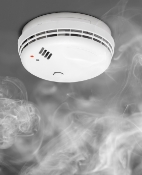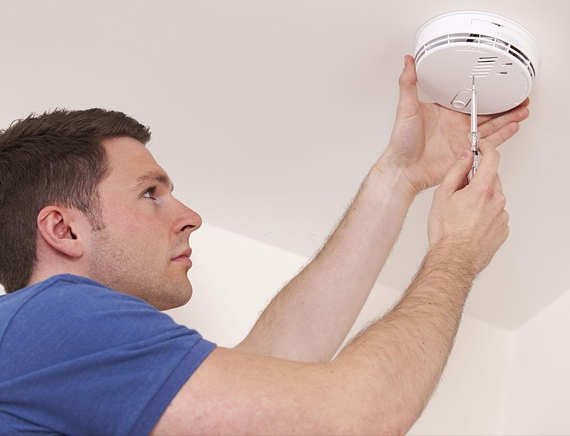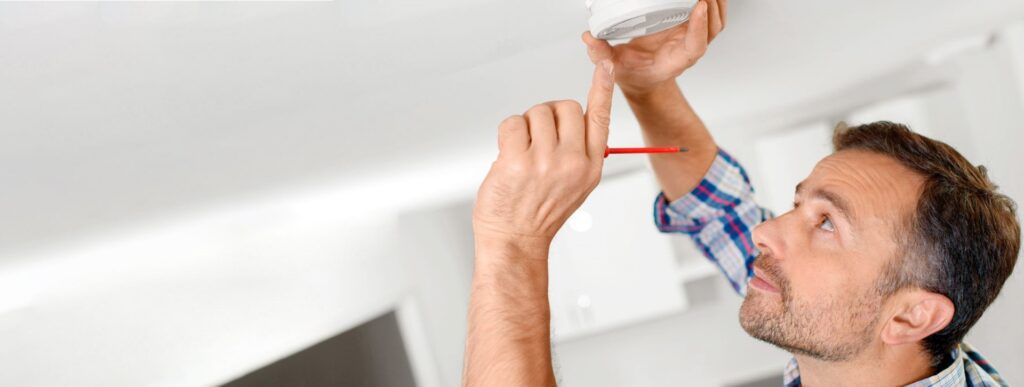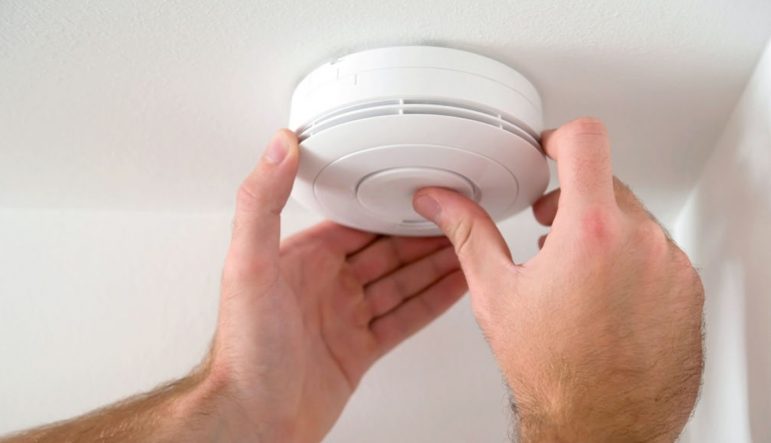Where to Install Carbon Monoxide Detectors?…
It goes without saying that carbon monoxide (CO) detectors are vital for the well-being of you and your family if you own a house or lease it. You may not know where CO sensors should be installed and where they shouldn’t be.
We’ll explain where and how to put CO monitors here as well as how to maintain or use other precautionary steps to make the most out of them. Let’s get going!
Why Are CO Detectors Imperative?
Intoxication by carbon monoxide can happen if a person inhales too much of the gas. CO mainly affects the lungs once it is absorbed and then quickly makes its way into the bloodstream.
Haemoglobin in the bloodstream is bound by carbon monoxide, which prevents it from reoxygenation. The damaged haemoglobin, which is now known as carboxyhemoglobin, builds up in the bloodstream and prevents cells and tissues from receiving oxygen. When tissues stop getting enough oxygen and start to die, it does a lot of damage to the body and stops working properly.
The heart and peripheral nerves are among the physiological functions that experience the most serious complications of carbon monoxide poisoning. The effects of carbon monoxide poisoning are thus harsh and occasionally lethal.
Although some carbon monoxide deaths are brought on by extreme incidents like fires, the overwhelming bulk of such fatalities might well be avoided through the use of a carbon monoxide smoke detector.
Without an electronic carbon monoxide leak detector, it is impossible to track a carbon monoxide leak because it cannot be seen or smelt. You will be informed whenever the amount of CO in the atmosphere becomes unsafe by these efficient sensors.
While carbon monoxide detectors are by far the most reliable way to stop CO exposure, parents and households frequently forget to use them, placing the safety of the entire family in danger.
How Do Carbon Monoxide Detectors Work?
A carbon monoxide alarm is a compact device with just a few essential components. A small detector box with a CO monitor receives an electrical current from a silicon microprocessor enclosed in a plastic casing.
This detector has the ability to find and quantify the atmospheric carbon monoxide content. The detector will set off an alert if it finds significant CO quantities. The electricity in the building or a rechargeable battery can turn on the CO sensor.
CO detectors can additionally have an LCD, a testing key, and energy indication lights. When in a warning, versions with LCD screens can show the CO amount and the equipment condition. An energy indicator feature lets you know if the device is working or whether the battery needs to be replaced.
The safest alternative for households is to use a rechargeable battery-operated carbon monoxide detector as it will continue working in the event of an electricity outage. People frequently use gasoline barbecues to cook during prolonged power failures like those caused by a natural calamity.
They also use portable generators to provide electricity at these times. External barbecues and gasoline generators, however, still face the possibility of CO leakage if used inappropriately and located outside the house. Families can still be warned of hazardous CO leaks when power is absent or inconsistent by utilizing a rechargeable battery-powered carbon monoxide detector.
You may also like to read:
- 7 Steps to Help Prevent the Spread of Fire in Warehouses
- 10 Ways to Identify Fire Hazards at Your Workplace
- Here’s Why Fire Hydrants Come in Different Colours
- How to Change the Battery in Your Smoke Detector
How Long Do Carbon Monoxide Detectors Last?
Replace the batteries either once or twice per year when you’re using a battery-operated carbon monoxide detector. Quality carbon monoxide detectors will be included with lithium cells that can last up to a decade.
To help ensure your cells are in good shape, it is better to test them sometimes. A CO detector with old batteries won’t be of any value in avoiding contamination because batteries degrade over time.
Whenever you change your clocks each summer and autumn, it’s a brilliant idea to recall to inspect or replace the cells in your carbon monoxide detector. Use the “Test” button on your CO detector to make sure that it’s working properly.
Places to Install Carbon Monoxide Detectors

Install CO detectors regardless of the size or structure of your residence:
- Each and every story of the building, even the basements
- Close to sleeping areas and within 10 feet of your doors and windows
- Above any linked garage or close to it
Given the fact that CO is lighter than air in the atmosphere, CO detectors should be installed at least 5 feet above the ground. If you’d like, you can also mount the CO sensor on the ceiling.
Places to Not Install Carbon Monoxide Detectors
If you place a carbon monoxide sensor in these locations, you risk receiving false alerts or potentially causing harm to your gadget:
- Close to or above devices that produce fire or any kind of flame
- Inside 15 feet of cooking or heating components
- Surrounding humid places, such as restrooms
- In the path of youngsters or animals, it could result in unintentional interference or tampering of the gadget
The manufacturers’ instruction manual for your carbon monoxide detector must include more specific information on how and where to place your carbon monoxide sensor.
When you are uncertain about the optimum spots for CO detectors in your house, think about hiring an expert to install them. Again, for best protection against carbon monoxide poisoning, certified fire and safety services would be knowledgeable about the scenario and would be happy to set up your carbon monoxide detectors in key spots throughout the house.
Things to Look for in a Carbon Monoxide Detector

Are you wondering where to start while trying to get a carbon monoxide detector installed at your house?
Well, in that case, let’s go through some key factors you should look into while you are on the search for the perfect CO detector.
Mobility: If you are looking for something portable and compact that you can take around while travelling, then make sure you check the portability of the CO monitors that you are choosing.
Volume: The CO detector should have a minimum sound level of 85 dB, or roughly the same volume as a trash compactor.
Notifications: Different CO detectors emit various signals. Naturally, most of them will let you know whether there are harmful CO levels. A few even alert people if the voltage is depleted or when the levels of carbon monoxide have returned to normal limits. Loud alarms, audio warnings, or coloured lights can all be used for alerts. Additionally, search for CO sensors that have silence capabilities because it might be inconvenient to get your CO sensor to go off without a cause, much like how you can stop a smoke detector from beeping by switching off your smoke detector.
Expense: The price of CO detectors can vary from about $22 for a basic early warning model to $119 for the most sophisticated high-alert model. A CO sensor should cost you around $50 in general.
How to Maintain Carbon Monoxide Detectors?
Simply because you have finished setting up your carbon monoxide detector doesn’t really indicate you have finished maintaining them. Consider the following maintenance ideas:
- A carbon monoxide detector should be replaced every 5 or 6 years.
- One must keep the carbon monoxide alarm’s user manual close by so that you can really examine it.
- If the carbon monoxide alarm is cordless, inspect and/or replace the battery every six months.
- Do monthly testing on the sensor.
- Yearly, clean your alarm system to remove any dirt and other debris that might block the detectors and put them at a disadvantage.
How to Respond if Your Carbon Monoxide Detector Goes Off?

You’ll have to take rapid action if the sensor activates. A house safety policy that specifies what to do in an emergency event might save your life. Not every incident that sets off the CO sensor needs to be reported to 911. Checking for everybody in the household to see whether anybody is experiencing flu-like sensations like vomiting, dizziness, or migraines is a wise first move.
To prevent prolonged exposure to CO gas, leave your site if you or any of your family members fall sick. Ensure that all affected individuals call 911 and go outside to breathe fresh air. If nobody is ill, then you can get in touch with a professional expert or the fire brigade to look into the possibility of an issue.
Ventilate the bedrooms, restart the sensor, and switch off any fuel-burning equipment whilst you await professional advice outdoors or, if feasible, at a friend’s apartment.
The very first method for preventing carbon monoxide intoxication is choosing where and how to position your carbon monoxide alarms. Due to the fact that CO could be hazardous in small concentrations, you must also never forget to maintain your system.
You might be confused about where to get your carbon monoxide detectors for your household. That’s where TAS Fire Protection comes to your aid we are the best fire protection company in Canada provides you with all fire and safety services, including setting up carbon monoxide detectors as well. TAS Fire also offers regular fire inspections, security alarm services, emergency lighting services, fire sprinkler system installation & more also takes care of the replacement and maintenance as well.
Contact Us (905-870-7779) for a Free Consultation!
—

About TAS Fire Protection
TAS Fire Protection offers comprehensive and cutting-edge fire protection and security services to commercial, industrial, and high-rise properties. Our team of highly skilled professionals has years of experience in installing, maintaining, and inspecting fire alarm systems, fire sprinkler systems, fire extinguishers, fire hydrants, security alarm systems, and more. We understand that fire safety and security is essential to the protection of lives and property.
> Learn More

